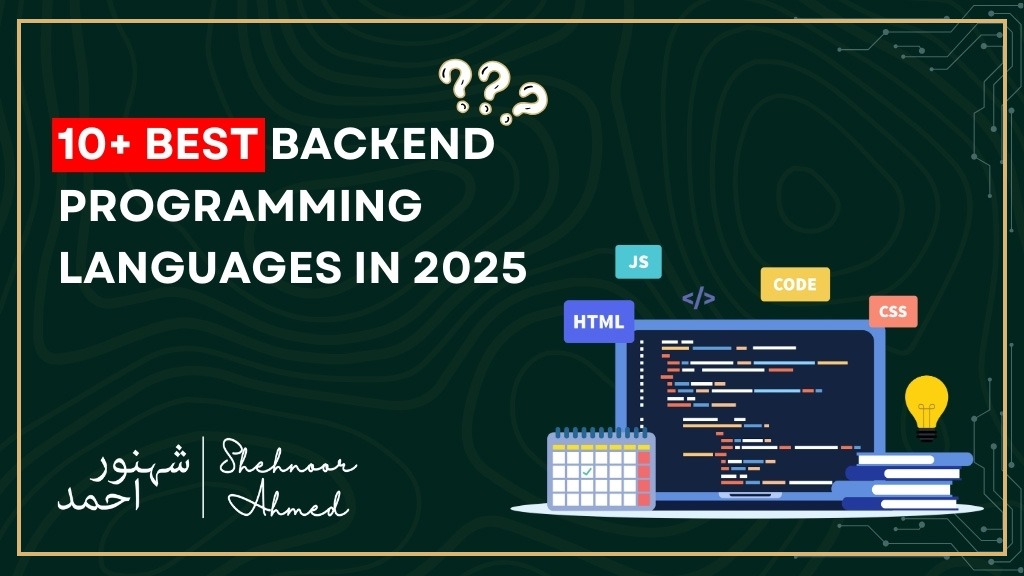
10+ Best Backend Programming Languages 2025
The majority of our activities today are conducted on computers or various smart devices. We all engage with different social media applications. Each time you click on a link or browse through your feeds, relevant information is presented on your screen is all coding language. However, have you ever wondered how this process works? The seamless user experience we enjoy is made possible by the backend of applications. Specific backend programming languages facilitate a smooth user experience and are crucial for strong backend development. Program for web development typically consists of both front-end and back-end components. Front-end languages such as HTML, CSS, and JavaScript programming language cater to the client side and what is visible on the screen, while back-end website development supports the server side or the operational aspects of a website or application. Gaining knowledge of back-end languages enhances your capabilities as a well-rounded development professional. If you are interested in learning more about the most widely used backend best programming languages and their applications, you have come to the right place. We will cover a comprehensive range of topics related to backend website development and its associated backend programming languages. What is Backend Development? Backend development constitutes a crucial element of web development, concentrating on the creation and upkeep of the server-side components of a website or object oriented programming. This segment of the development process is responsible for managing the underlying functionality, data handling, and the interaction between the server and the client-side (front-end) of a website. Backend developers oversee the server that hosts the website or web application. Their responsibilities encompass setting up and configuring the server, ensuring its security, and enhancing its performance. Additionally, backend developers are tasked with designing and maintaining the database systems that store and manage the data associated with the website. This includes the creation of database schemas, optimization of database queries, and safeguarding data integrity and exactly the best computer programming language to learn for web development. Furthermore, these developers write code to manage server-side logic, which entails processing user requests, handling authentication, and implementing business logic as a best coding language to learn. They are responsible for determining how data is retrieved and displayed to the user. What Are Backend Programming Languages? Backend programming languages are utilized by developers to create the internal systems that function behind the scenes of any web application and in most demand coding language. The backend software is the component that remains hidden from the end user. Prominent backend basics programming languages possess distinct characteristics that facilitate communication with the server, enabling users to send and receive information and data. If you are a backend developer or aspire to become one also the best computer programming language to learn, you may employ these architectural programming languages and frameworks for various projects, including: ● Websites ● Collaborating online tools ● Mobile applications ● Desktop applications ● Web servers ● Software prototypes ● Online games ● Security features ● Data assortment ● Networking. Performance Considerations Development Efficiency Maintenance demands Security Features User action response time Market readiness timeline Sustainability over time Integrated security functionalities Utilization of server resources Availability of developers Efficiency in bug resolution Management of exposures Scalability potential Cost of development Management of updates Compliance features We will examine the best programming languages to learn for backend development in 2025, evaluating their advantages, applicable scenarios, and the reasons they may be suitable for your project. Python: In 2025, Python has emerged as the most popular backend programming languages, transforming the landscape of web application development. Its significant rise in popularity can be attributed to its exceptional readability and extensive ecosystem. Organizations favor Python web development as it significantly reduces development time compared to conventional programming for data analysis. For both startups and established enterprises, the Django and Flask frameworks offered by Python developer roadmap facilitate the creation of robust web applications in a straightforward and cost-efficient manner. Key features of Python include: Benefits Drawbacks User-friendly & easily comprehensible arrangement A vast standard library along with numerous community-contributed modules Accommodates programming examples Seamlessly integrates with other programming languages and systems Facilitates rapid python web development through backend frameworks such as Django and Flask Slower Execution speed The Global Interpreter Lock (GIL) may restrict the performance of multi-threaded applications Consume a significant amount of memory Not suitable for mobile apps Prone to runtime errors as a result of dynamic typing. JavaScript (Node.js) JavaScript, utilized through Node.js, has revolutionized server-side programming as a highly adaptable backend programming languages. Its capacity to manage both frontend and backend development renders it an economical option for enterprises. The non-blocking, event-driven framework is particularly suited for real-time applications that require full stack development and management of numerous simultaneous connections. Key features of JavaScript: Benefits Drawbacks Unified language for both client-side and server-side development Ideal for input/output-intensive operations Extensive ecosystem supported by NPMs Enhanced performance through the V8 engine in Node.js Robust community support offering a multitude of libraries and frameworks Challenges associated with callback and details of managing asynchronous code Dynamic typing may result in runtime errors Maintenance can be challenging due to its adaptable syntax Potential performance limitations in CPU-intensive tasks. Java As a prominent backend language in web development, Java programming language remains a leading choice for enterprise applications. Its “Write Once, Run Anywhere” feature ensures reliability across various platforms as most used programming language. The spring framework ecosystem offers robust, enterprise-level functionalities right out of the box. Key features of Java: Benefits drawbacks Platform independence is achieved via the Java Virtual Machine (JVM). The programming languages offer strong memory management & security capabilities. It is supported by comprehensive standard libraries and a variety of third-party tools.Java is also scalable, making it suitable for large applications & full stack web development. Additionally, there exists a vast developer community and ecosystem surrounding Java. The verbosity of the language may result in extended development periods. The startup time can be slower because of



